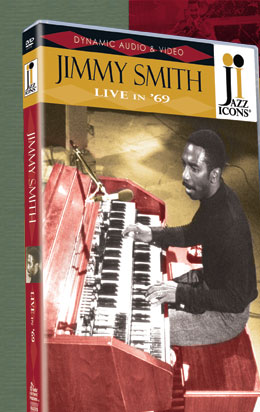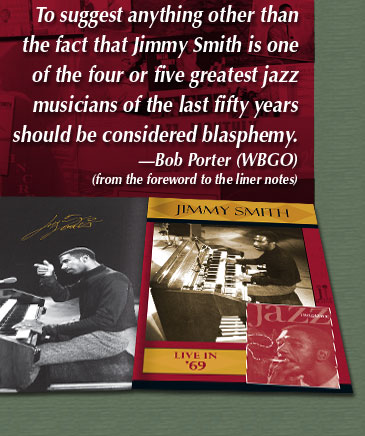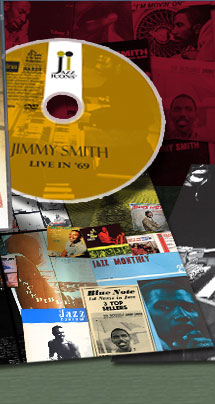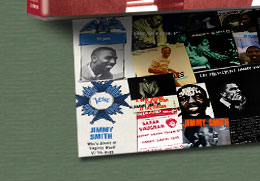




 |
 |
|
|||
|
|
|
||||
|
|
|
||||
|
|
|
||||
|
|
|
||||
 |
|
||||
 |
|
||||
 |
|
||||
|
|
|
|
|
|
|
| Jazz Icons: Jimmy Smith boasts an incredible 90-minute concert from 1969 filmed in Paris. Working in his classic trio format (with longtime guitarist Eddie McFadden and drummer Charlie Crosby), Jimmy shows why he is still the uncontested king of the jazz organ. Highlights include blues jams “Got My Mojo Working” and “Sonnymoon For Two,” the classic ballads “Alfie” and “Satin Doll,” as well as a blinding 23-minute version of his showcase number “The Sermon.” | |
 |
|
|
|
|
24-page booklet Liner notes by Ashley Kahn Foreword by Bob Porter, WBGO Cover photo by Jan Persson Booklet photos by Chuck Stewart, Lee Tanner, Jan Persson Memorabilia collage Total time: 90 minutes |
|
|
Foreword: In this 1969 concert, Jimmy Smith was still at the top of his game. Trim and dapper, his enthusiasm in his playing is obvious from the start. The camera angles give us special insight into how Jimmy Smith did the remarkable things he did. Watching his performance of “The Sermon” is indeed special. We are permitted to see the entire instrument. Watching his left hand walk the bass on the lower manual is to witness a technique he invented. When he begins the drone with his right thumb and begins to improvise with the remaining fingers, he gets fired up and deeply into the feeling. This is one great piece of jazz video. BOB PORTER
Sample Liner Notes by Ashley Kahn: By 1969, Smith was a well-traveled crowd-pleaser, a seasoned headliner well known on both sides of the Atlantic. His influence had launched a jazz subgenre and was starting to be felt in the rock world in the Hammond playing of Brian Auger, Gregg Allman, Keith Emerson, Jon Lord (of Deep Purple) and Gregg Rolie (Santana). A winter tour that year found Smith performing in London, Paris and other major European cities with his standard trio format featuring Eddie McFadden, who had played guitar on more than a few of Smith’s late 1950s Blue Note sessions, and Charles Crosby, a Memphis native known for his years drumming with B.B. King and later Rahsaan Roland Kirk. It is a measure of Smith’s stature overseas that through the 1960s he was regularly contracted by France’s leading jazz impresario team to play the top venues in the country. Daniel Filipacchi and Frank Ténot had enjoyed repeated success presenting Smith in Paris’s fabled Salle Pleyel — the theater in which a long line of jazz legends had performed from Django Reinhardt and Duke Ellington to Dizzy Gillespie and Miles Davis. Many historic jazz concerts were recorded there including one by Smith — a May 28, 1965, performance released as Live In Concert on Verve’s sister label Metro. Four and a half years later, Filipacchi and Ténot booked Smith for a one-night, two-set show at the Salle. This time, it was TV cameras capturing the evening’s performance; the producer was the country’s first black television producer, Gésip Légitimus. The taping resulted in two programs broadcast on French television, Smith’s second set from that evening aired in 1969, and his first set two years later. This DVD returns the performance to its original sequence. Though not in step with the colorful, dress-down fashions on the street, the Jimmy Smith Trio looked sharp in the formal wear that had been the uniform for festival and theater engagements only a few years before. The two-part performance, aided by a generous number of camera angles and close-up shots, offers an insider’s take on the dynamics of Smith’s organ trio. He frequently cedes the first solo of a tune to McFadden, the more laid-back of the two, as a means of setting up his own improvisation. Some tunes obviously have been worked out — note McFadden’s taking the B part of the “Satin Doll” melody at the close of the second set — but Smith seemed to enjoy surprising his sidemen with unexpected leaps in volume or changes in melody. Crosby’s deft switching between sticks, brushes and mallets (even tambourine at one point) speaks to the intense follow-the-leader nature of the group. Smith’s organ sound is itself a revelation. In the 1950s, when he played single note lines, he tended to keep the Hammond’s “chorus” effect switched on — adding a small quiver to the instrument’s tone — and turn off the rotor in the Leslie (which only offered an “on” or “off” option). By 1969, the Leslie came with a slow or fast speed, and Smith changed his organ sound. He cut off the chorus, which produced a straighter organ tone, and relied on the rotors on the Leslies (Smith used two cabinets onstage) set on the “slow” speed, to be a dominant factor in his overall sound. The result was a large, wavy sonority on which the chords would float. The concert also provides a look at Smith’s choice of material at the time. Many of the tunes were drawn from recent Verve albums: a mix of older standards, a recent pop hit, a few down-tempo ballads, blues numbers (including a vocal), signature jams from his Blue Note years and “Satin Doll” — the Duke Ellington nugget Smith used to signal the close of his set. Speaking of song choices: it’s intriguing to note that, though the trio was apparently not working from a planned set list, Smith devoted the first set of the evening mostly to ballads and the second to blues.) Smith’s solo on “Sonnymoon” immediately reveals another innovation in his playing since the 1950s. He is using a more modern harmonic language, favoring a lot of “fourths” – chords constructed of the fourth interval (in contrast to traditional chords based on the third), the same idea favored by pianists Bill Evans (on Miles Davis’ Kind Of Blue) and McCoy Tyner (with John Coltrane in general). Chord voicings employing fourths are noted for producing a more abstract effect, neither major nor minor, “because they avoid the familiar ring of popular songs,” according to jazz historian and pianist Lewis Porter. Just over a minute into his solo, Smith invents a lyrical line reminiscent of “Freddie Freeloader” (also from Kind Of Blue) that utilizes fourths for one chorus, a harmonic cue that McFadden follows on guitar. All words and artwork on this page ©Reelin' In The Years Productions. Unauthorized use is prohibited.
|
|
Site contents ©Copyright 2009 Reelin' In The Years Productions
Site designed by Tom Gulotta